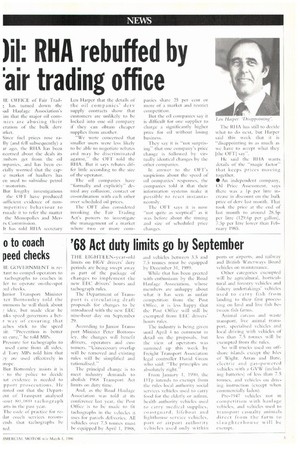THE EIGHTEEN-year-old limits on HGV drivers' duty periods are being
Page 3

If you've noticed an error in this article please click here to report it so we can fix it.
swept away as part of the package of changes to implement the new EEC drivers' hours and tachograph rules.
The Department of Transport is circulating draft proposals for changes to be introduced with the new EEC niise-hour day on September 29.
According to _Junior Transport I'vlinister Peter Bottomley, the changes will benefit drivers, operators and customers, "Unnecessary overlap will he removed and existing rules will be simplified and rationalised,
The principal .change is to meet industry dein:nick to abolish 1968 Transport Act limits on duty time.
And, as the Road Ilaulage Association was told at its conference last year, die Post ()like is to be made to lit tachographs in the vehicles it uses for parcels deliveries. All vehicles over 7.5 tonnes must be equipped by April I, 1988, and vehicles between 3.5 and 7.5 tonnes must be equipped by December 31, 1989.
While that has been greeted with enthusiasm by the Road Haulage Association, whose members Are unhappy about what it has seen as unfair competition from the Post Office, it is less happy that the Post Office will still be exeinpted from EEC: drivers' hours rules.
The industry is being given until April 4 to comment in detail on the proposals, but the view of operators was summed up this week by Freight Transport Association legal controller David Green who said: ''The principles arc absolutely right."
From January 1, 1990, the DTp intends to exempt from the rules local authority social services vehicles used to carry food for the elderly or
health authority: vehicles used to carry nicJical supplies, coa:,tgudril, lit-el:mat and lighthouse service vehicles, Pitt or airport authority vL'hicles used only within
ports or airports, and railway and British Waterways Board vehicles on maintenance.
Other categories exempted will be agricultural, horticultural and forestry vehicles and fishery undertakings' vehicles used to carry fish from landing to their first processing on land and live fish between fish farms.
Animal carcass and waste transport, live animal tr.msport, specialised vehicles and local driving with vehicles of less than 7.3 tonnes will be exempted from the rules.
So will trucks used on offshore islands except the Isles of Wight. Arran and Bute, electric and gas-powered 's eludes with a C .V W (including batteries) of less than 7.5 tonnes„md vehicles on driving instruction (except when commercially laden).
Pre-1947 vehicles nor in competition with haulage vehicles, and vehicles used to 'transport casualty animals direct from the raT111 to slaughterhouse will be exempt.




























































